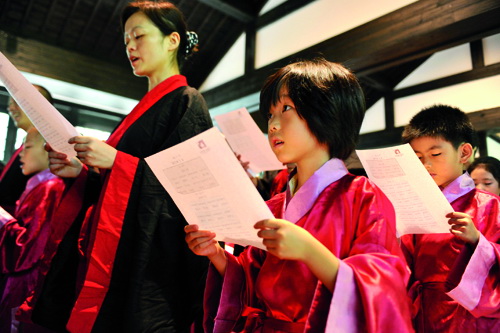 |
|
Students at Sishu must wear Hanfu |
Worldwide, Qipao, a close-fitting women's dress with a high neck and slit skirt, is recognized as the main symbol of China's national costume. But today in China, many are trying to change this impression.
As the largest of China's 56 ethnic groups, Han Chinese account for more than 90 percent of China's population. Han-style costume (Hanfu) was the mainstream style of clothing in ancient China for about three millennia. This changed when the Manchurians came to power, founding the Qing Dynasty (1644-1911). The now-famous Qipao is the modern version of Manchu clothing worn by women.
But in recent years, more and more Hanfu enthusiasts are dedicating themselves to bringing back this lost style of dress, and with it, bringing about a resurgence of traditional Chinese culture in modern Chinese society.
Cultural identity
To celebrate her 25th birthday, Yang Fan went to a popular photographer's studio last autumn to take a series of glamor shots of herself in Hanfu clothing. She was satisfied with the pictures, but frustrated that she often was complimented by people saying, "Oh, you look so pretty in a kimono (Japanese traditional costume)."
"This is sad," said a disappointed Yang. "When people see an ankle-length gown with long, full sleeves and a V-neck, they rarely recognize that it could be Chinese clothing."
In fact, both Japanese and Korean traditional costumes developed under the influence of Han styles as Chinese culture spread to other Asian countries. Nowadays, these traditional costumes are still worn in Japan and Korea at special celebrations or events, and even in daily life. But in China, Hanfu clothes have only appeared on screens and stages.
"Clothes are like our skin," said Yang. "Our national costume displays our culture identity."
|